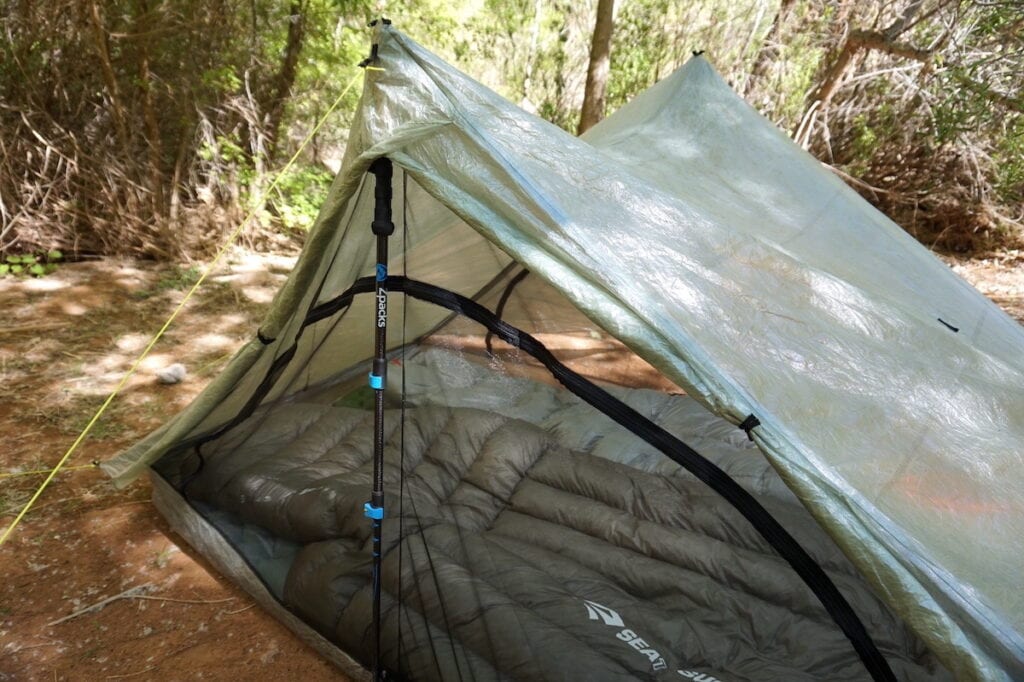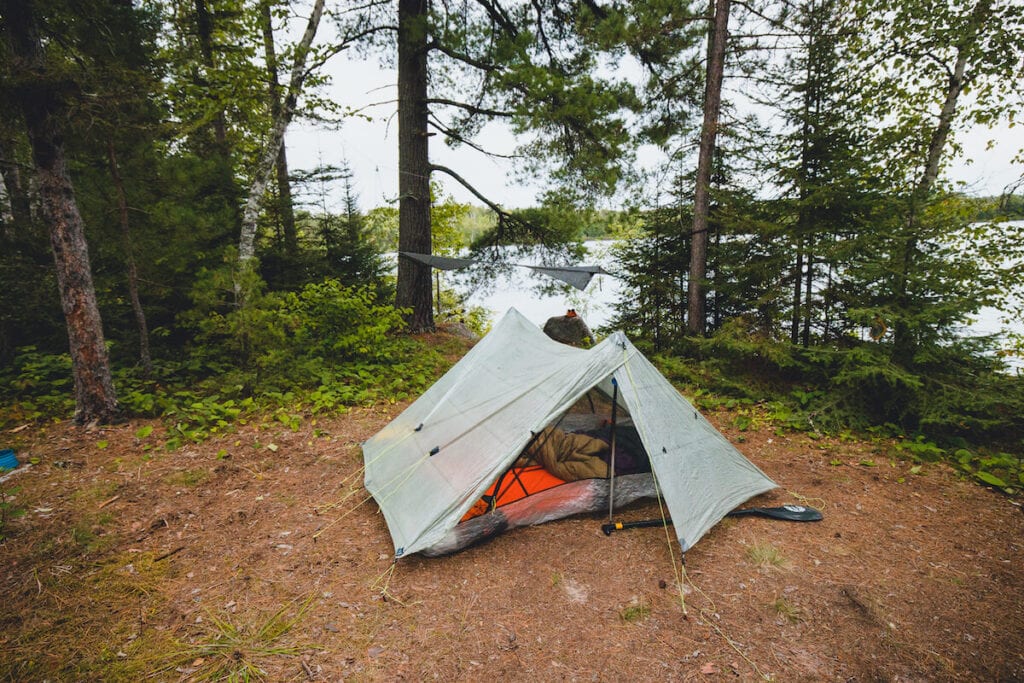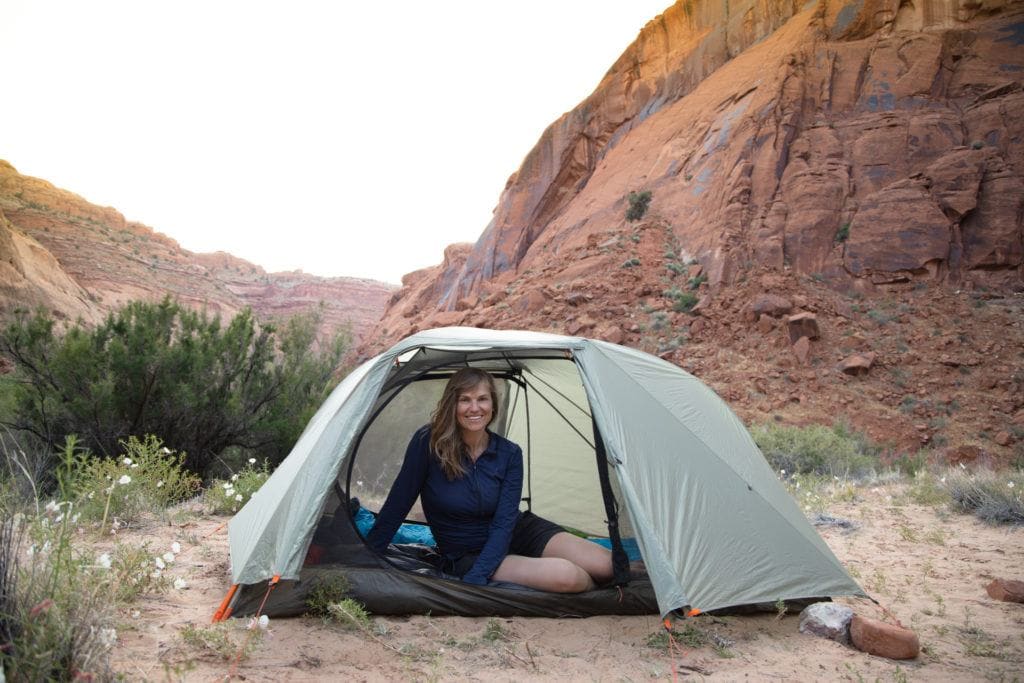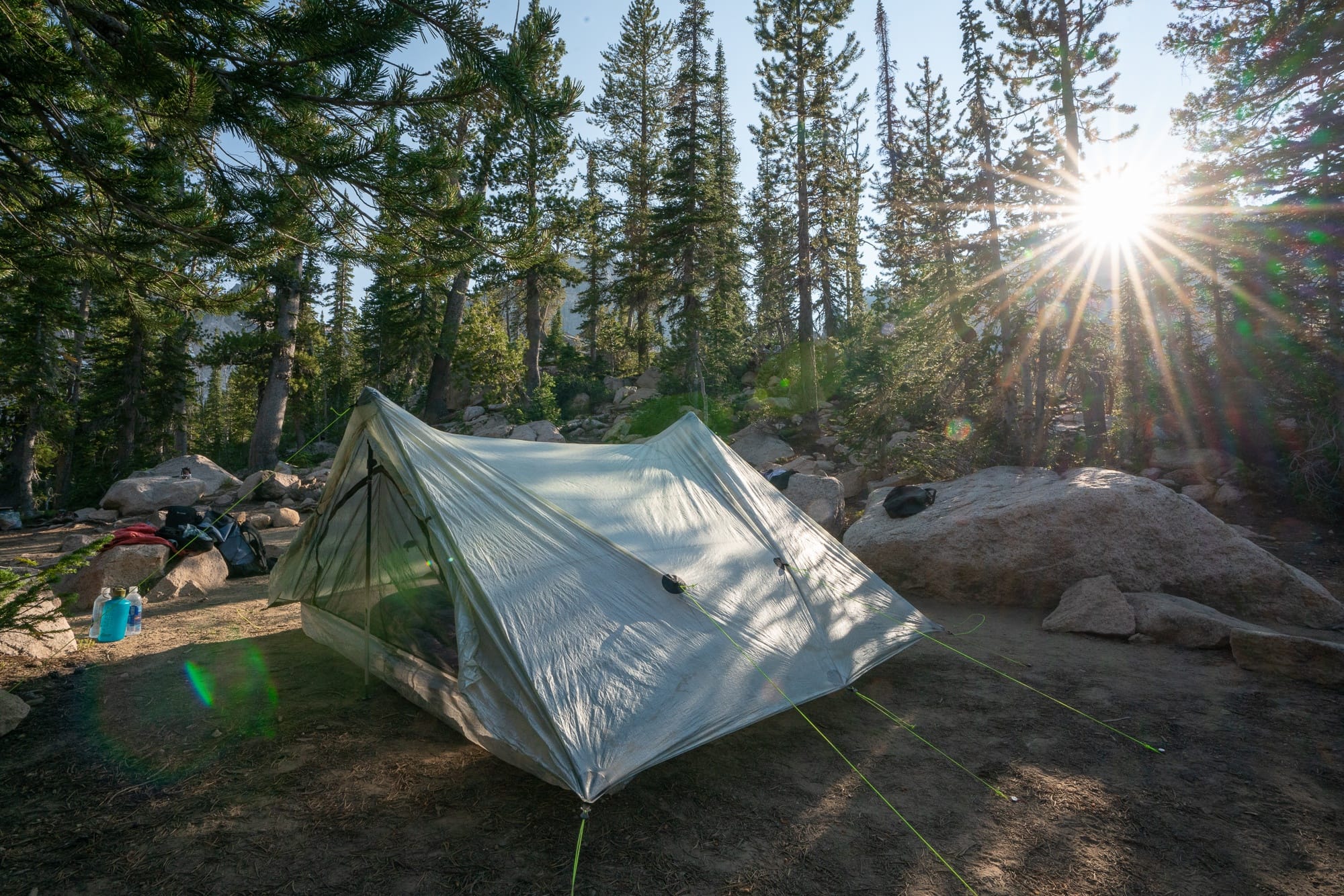7 Best Backpacking Tents in 2024
Get recommendations for some of the best tents for backpacking and learn the most important factors to consider when shopping for a new tent.

The best backpacking tents are lightweight, durable, weather-proof, and a cinch to set up. Sounds simple enough, but a good backpacking tent is an investment and with all the choices out there, picking the right one can quickly get overwhelming.
We’ve collectively tested dozens of backpacking tents in a variety of conditions from quick weekend trips to multi-day backcountry adventures and even through hiking the John Muir Trail and Pacific Crest Trail.
In this guide, we’ve rounded up the best lightweight tents for backpacking in 1-person, 2-person, 3-person, and even 4-person sizes to help you narrow down your search and find the right tent for you.
Plus, at the end of this post, you’ll find more info on what features to consider when shopping for a backpacking tent and how to choose the best backpacking tent for your needs.
Best Backpacking Tents at a Glance
Tip: The packaged weight includes everything that the tent comes with including stakes, stuff sacks, and guy lines. You can shed a few ounces by swapping out the stakes for lighter ones like these aluminum tent stakes.
This post may contain affiliate links.
Save this post!
Enter your email & I'll send this post to your inbox! You'll also receive my weekly newsletter full of helpful advice for planning your adventures.
1. REI Half Dome SL 2+
Bearfoot Theory Reader Favorite
Key Features
Where to shop
One of our top picks for backpacking tents here at Bearfoot Theory is the REI Co-op Half Dome SL 2+. While it’s not the lightest tent on our list, it’s durable and easy-to-set up, both of which are priorities in our book. This tent is the perfect option for casual backpackers looking for a high-quality shelter at an affordable price point. Additionally, the Half Dome is consistently one of REI’s best sellers and we agree that it’s a solid choice for most backpackers.
A few key features of the Half Dome include ample interior space for two people plus gear and pets (hence the 2+ size) as well as two doors and vestibules that provide easy access and plenty of storage options. The Half Dome 2 is also well-ventilated with mesh panels that keep the interior from getting stuffy on hot nights.
2. Zpacks Duplex 2P
Best Ultralight Backpacking Tent
The Zpacks Duplex tent is a single-walled, ultra-lightweight 2-person backpacking tent. Weighing just 1 lb 3 oz and roomy enough to sleep two, it’s a great choice for long-distance backpacking trips where weight really matters. This tent is consistently at the top of the list for PCT and JMT thru-hikers.
Since the Zpacks Duplex is a tarp-style tent rather than a freestanding one, it does require a little more effort to set up right. It utilizes trekking poles instead of tent poles (although you can purchase Zpacks tent poles or the freestanding flex kit separately if you prefer a freestanding tent).

On normal ground conditions, the Duplex is easy to set up. I’d just recommend watching a video or reading the instructions on the Zpacks website before heading out just to make sure you are confident since it’s not a freestanding tent.
On rocky surfaces, the Zpack Duplex can be a bit challenging to set up because it’s semi-freestanding. The corners need to be staked out and the tarp supported with upright, stable trekking poles, which is hard to achieve on hard surfaces. On my recent trip to Sequoia National Park we often camped on granite rocks, so getting the tent set up was a bit tricky. But with some creativity, like using rock to stabilize the tent, you can get by. You’ll also need 8 stakes (sold separately) and I recommend the ultralight carbon fiber ones.
A few key features of the Zpacks Duplex tent include four storm (vestibule) doors that can open or close independently depending on the weather and climate. On a nice clear evening, you can keep the vestibule doors open and stargaze right from your bed. I recommend keeping at least one door open (weather permitting) to reduce the amount of condensation buildup overnight.
It also has 2 mesh pockets for storage, extremely durable fabric (a footprint is not necessary, but can be bought separately if desired), and a built-in design to prevent condensation from dripping onto the floor.
This is a single-walled tent and the fabric is completely waterproof. I’ve used this tent during several days of consecutive rain and heavy winds in the Boundary waters and we stayed dry as a bone inside. I also couldn’t believe how sturdy it was!
However, because it is single-walled, this backpacking tent can be prone to condensation which sometimes might require you to put it away wet in the morning.
If you want even more room, I’ve been using the Zpacks Triplex (3-person version) of this tent for years. We got the Triplex because it’s still light and compact, but it’s roomy enough for us and our two dogs. Even the Triplex version packs down smaller than any of my freestanding two-person tents!
Read next: Want to learn more? Read our full review of the Zpacks Duplex Tent.

3. NEMO Dragonfly Osmo 2P
Best lightweight freestanding tent
Key Features
Where to shop
If weight is a priority for you, but you still want a freestanding tent, the NEMO Dragonfly Osmo is a great choice. The 2-person tent weighs just 2 lbs 10 oz and doesn’t sacrifice any of the features you expect in a backpacking tent.
It’s designed with NEMO’s proprietary OSMO fabric, which is highly waterproof, durable, and made from recycled materials. The Dragonfly also has great storage options including a gear loft and gear pockets as well as a nightlight pocket that you can stash your headlight in once the sun sets.
One cool feature the Dragonfly has that I haven’t seen in other backpacking tents is the included divvy sack that allows you to split the weight evenly between two backpackers.
NEMO Equipment offers a lifetime warranty, but I recommend grabbing the footprint to help protect your tent against stop rocks and thorns.
If you want a roomier tent, check out the Nemo Dagger, which is very similar to the Dragonfly, but a bit larger. Or, if you plan on doing multi-sport adventures, check out the NEMO Dragonfly Bikepack tent, which has shorter poles to fit into bikepacking bags.
4. Sea to Summit Telos TR2
Most innovate features
Key Features
Where to shop
Sea to Summit has really upped the game when it comes to innovative backpacking tent features. With the Telos TR2 tent, backpackers can enjoy a range of unique set-ups including a shade tent that utilizes two trekking poles. It can also transform into an ultralight setup that just uses the rainfly or set up the rainfly first if you’re caught in a downpour.
The Telos is also designed with an inverted Tension Ridge pole structure that allows for more room inside and better ventilation.
One cool feature that I haven’t seen in other backpacking tents is the separate stuff sacks that allow you to pack your backpacking bag more efficiently or distribute the weight among friends.
The Telos TR tent is truly innovative and a great choice for backpackers who want versatility out on the trail.

5. SlingFin Portal 2
Strongest & most durable tent
Key Features
Where to shop
SlingFin is a lesser-known backpacking gear brand based out of Berkeley, California. They’re known for designing high-quality gear that can withstand the elements and wear and tear of the trail. The SlingFin Portal 2 tent is one of their most popular products thanks to its stable and strong construction. It’s designed to hold up in windy and adverse conditions. Hikers who use this tent report that they stay dry and warm even throughout intense thunderstorms and downpours.
This tent also has some great features like KickStand vents to optimize airflow, a fly-first set up if you get caught in a storm, and the option to purchase a ‘tub floor’ that replaces the mesh tent for a lighter set up on bug-free and dry adventures.
We haven’t tested out the SlingFin Portal ourselves, but the great reviews and attention to detail make the SlingFin Portal one of the best backpacking tents on the market.
6. REI Co-op Trailmade 2
Best Budget Backpacking Tent
Key Features
Where to shop
While all the tents on our list are pretty easy to set up, the REI Co-op Trailmade 2 Tent takes the cake. Two poles cross over in a straightforward design making setup plain and simple.
While this tent is on the heavier side of backpacking tents (5+ lbs), it’s a basic, budget option that will allow you to get out on the trail and sleep comfortably in the backcountry. Plus, the footprint is included, which isn’t the case for most backpacking tents.
The Trailmade 2 has two doors and two vestibules so you won’t have to climb over your tent partner and the height and non-tapered design make this tent feel relatively spacious. The mesh canopy allows for stargazing and open-air sleeping without the bugs, and the ceiling vents help with airflow even when the fly is on.
Overall, the REI Trailmade tent is a no-frills, budget-friendly option for those just getting into backpacking or who don’t mind carrying a bit of extra weight.
7. Marmot Tungsten UL 4P Tent
Best Backpacking Tent for Families
Key Features
Where to shop
The Marmot Tungsten UL 4P Tent is a freestanding 4-person option that is great for families or backpackers traveling with large dogs. It is heavy at almost 8 lbs, but if you’re looking for a spacious tent for short backpacking trips with the kids, it could be a good option.
The mesh canopy allows for airflow and stargazing when the weather’s clear while the solid tub lining along the bottom stops dust and water from entering.
The Tungsten has dual doors (although they are on the small side) as well as vestibules and multiple interior pockets for easy organization. The color-coded clips are a nice touch that make for a super easy set-up.
How to Choose the Best Backpacking Tent
Shopping for a lightweight backpacking tent can quickly get overwhelming with all the options out there, not to mention pricey. To help you hone in on what’s most important to you in a good backcountry tent, here are the main features you’ll see mentioned, what they mean, and some helpful things to consider when making your decision.
Tent Weight
When searching for a backpacking tent, weight is the first factor I consider. Most backpacking tents weigh somewhere between 1-4 pounds. The lighter the tent, the more comfortable you are going to be when you are carrying it on your back.
That said, there is often a trade-off between weight and durability. Ultralight tents require more care when setting them up and storing them when you get home. They also come with a heftier price tag.
When comparing tents, you’ll typically see two different weight specs:
Realistically, you’ll likely be carrying something close to the packaged weight since you’ll want to bring the tent, fly, poles, stakes, and guy lines. One way to save weight is to swap the stakes that come with the tent with a set of lightweight aluminum stakes.
Some of the tents on this list also have a minimalist pitch option where you can bring just the fly, footprint, and poles to make a lightweight shelter in fair weather.

Capacity / Interior Tent Space
Who and how many people will you be sharing your tent with? And how tall are you? Many of the 2-person backpacking tents (especially the ultralight options) are very tight for two people and have space for two sleeping pads directly next to each other and not much else.
If you plan to shack up with a friend or partner, or if you’re backpacking with your pup, you’ll want a 2-person backpacking tent at least. The best 2-person backpacking tents have two doors so you don’t have to climb over each other when getting in and out of the tent. Also, look for ones that have a good-sized vestibule (or two) so you have space to stash your backpacking packs and hiking boots in case of rain.
If 3 people will be sharing a tent or if you and your partner or friend are backpacking with your pup, you’ll want a 3-person backpacking tent. This is what I backpack with most often since my partner and I typically backpack with our dogs, Charlie, who is a diabetic alert dog, and Gumbo.
Things to pay attention to when choosing tent size are:

Number of Doors
Two doors will make getting in and out of the tent way more comfortable when you are camping with someone else. It means you won’t have to crawl over each other and in most cases, you will also have your own separate vestibule to store your stuff which helps you stay more organized and to keep your gear dry in case of rain. (A vestibule is the area outside of the tent door underneath the tent fly).

Seasonal Rating
A majority of backpackers will be fine with a 3-season tent which are designed to breathe well in moderate weather conditions (including heavy rain and light snow) during spring, summer, and fall.
If you plan on camping in heavy snow or in extreme, exposed conditions, you may need a 4-season tent. Four-season tents have less mesh and retain heat better, but the lack of ventilation can make them feel a bit stuffy.
Wall Construction
Most of the popular backpacking tents are double-walled – which means they come with the actual tent as your shelter and a separate rain fly that you can attach to the outside of the tent for weather protection. Double-walled tents have better airflow and experience less condensation due to airflow.
A single-walled tent is weatherproof all around without the need for a fly and that often helps shave off some weight. But single-walled tents also typically have no windows and no mesh. This means that condensation can be a problem in wet conditions. It also means that you likely won’t be able to do any stargazing from bed or have the option to sleep in the open air since there is no removable fly.
Single-walled tents are best for cold, dry conditions (like the southern Utah desert in early spring).
Freestanding vs Tarp-Style
A freestanding tent is one that comes with poles that support it. They are quick and easy to set up and can be pitched almost anywhere, which is why this style is more popular.
A tarp-style tent (like the 3-person Zpacks tent below) is one that you set up using your trekking poles for support and by tying guy lines to stakes, trees, rocks, etc to get it taut. Tarp-style tents are lighter since they don’t have poles and tend to appeal to experienced long-distance hikers looking to save weight.
A few of the tents on this list are semi-freestanding, meaning they can stand on their own but do need to be staked out for full functionality and weather protection.

Save this post to Pinterest
What backpacking tents have you tried? Do you have any questions about picking the best backpacking tent? Let us know in the comments below.



